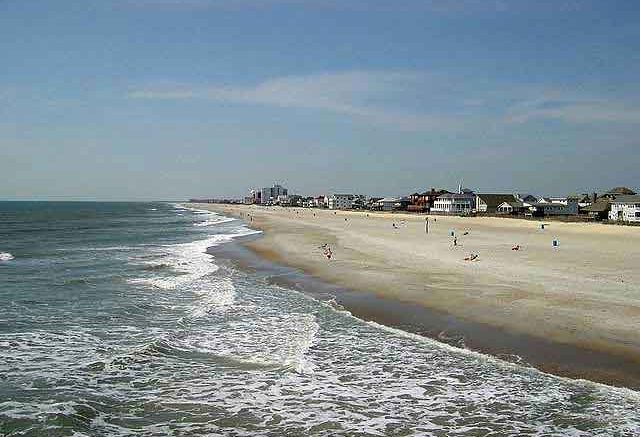Beachgoers in North Carolina have long enjoyed open access to the state’s 301 miles of shoreline – from the ocean’s edge to the waterside base of the shifting dunes.
At low tide, people might be walking, sunbathing on a towel, building sand castles, throwing out a fishing line or playing beach games on wet or dry sand. High tide might leave only a sliver of dry sand for the public access, but most beach visitors are accustomed to using that strip of shoreline, too.
Now a lawsuit filed by Emerald Isle beachfront property owners has roiled the waters on whether those long-held practices will be a part of future summers.
Gregory and Diane Nies, a retired couple from New Jersey who own a beachfront property at Emerald Isle, have asked the N.C. Supreme Court to review a decision by the state Court of Appeals from late last year that laid out where the line for public and private meet. The unanimous three-judge decision upheld an Emerald Isle ordinance barring beachfront property owners from putting any beach equipment or structures “within an area 20 feet seaward of the base of the frontal dunes.”
The intent of the 2010 ordinance, according to Emerald Isle officials, is to establish an upper beach lane through which garbage trucks, police, emergency vehicles and other public service activities can proceed unfettered by private structures.
The Nieses said in a telephone interview this week that they believe the town code limits them from using land that they contend is theirs.
The deed on their property says their lot line extends to the mean high water mark, which can shift over the years as rising tides and storms reshape the coastline. The Nieses said if Emerald Isle wants to restrict the use of their land, that constitutes a public “taking” and they should be compensated for it.
“We have never said people can’t walk on the beach,” Diane Nies said this week. “I think the town has purposely misconstrued this.”
Rolf Blizzard, chairman of the N.C. Travel and Tourism Coalition, a 30-plus member organization that joined with the N.C. Vacation Rental Managers Association to file a brief in support of the appeals court ruling, said reversing the appeals court decision could have a domino effect that would financially hurt other beach property owners whose homes do not front the ocean.
“If the public could no longer visit and relax on North Carolina’s beaches from the water’s edge to the sand dunes, then our coastal tourism would collapse,” Blizzard said. “This is a do-or-die issue for North Carolina’s economy and its regional, national, and global appeal.”
76 feet of beach
The Nieses said they regretted how they have been portrayed as retirees from New Jersey coming to North Carolina and trying to alter a longstanding understanding of beach access.
“If the court rules for us, it would affect 76 feet of the beach – this is about exactly one piece of property,” Diane Nies said. “The town is trying to confuse everybody.”
The case, though, has drawn the attention of powerful advocates on each side of two bedrock principles: public access to public beaches, and the right of private owners to exclude others from their property.
The Nieses are represented by the Pacific Legal Foundation, a California-based organization that has been a staunch advocate of property rights, which describes Emerald Isle as a government gone rogue.
“No one seeks to prevent emergency vehicles driving down the shore,” J. David Breemer, a principal attorney with the organization, said in an opinion piece published Aug. 10 by the Carteret County News-Times. “Claims to the contrary are just a smokescreen to shield the town from facing up to the real issue: commandeering private land for government use outside the lawful process of law. Property owners like the Nies deserve fairness and law, not ‘public trust’ tricks, when the government comes in and says ‘your land is now ours.’”
Frank Rush, the Emerald Isle town manager since 2001, has rallied other coastal towns and counties to the Carteret County town’s side in the court fight. By mid-August, six of eight oceanfront counties and 18 of 21 oceanfront municipalities had agreed to sign onto an amicus, or friend of the court, brief.
“The very definition of the area of the beach that the public is entitled to use will be determined by the Supreme Court,” Rush said in a telephone interview. Rush added in an email: “If the N.C. Supreme Court overturns the Court of Appeals ruling, and enables an oceanfront property owner to control the flat, sandy beach, it could have devastating impacts on recreational pursuits on the beach, the overall quality of life for our residents and visitors, the tourism economy, and the real estate market, among other things, all along the N.C. coast.”
The case has brought together Republican Gov. Pat McCrory and his Democratic rival for governor, state Attorney General Roy Cooper, in rare agreement. Cooper filed a friend of the court brief on behalf of the state.
Attorneys for the state departments of Environmental Quality, Commerce and Natural and Cultural Resources, part of McCrory’s executive branch, filed a similar brief citing the potential for environmental damage, lost tourism dollars and other concerns if state Supreme Court justices don’t uphold the N.C. Court of Appeals ruling.
Rooted in custom and history
Appellate Judge Linda McGee authored the November 2015 ruling that was signed onto by appellate judges Rick Elmore and Mark A. Davis.
“[W]e take notice that public right of access to dry sand beaches in North Carolina is so firmly rooted in the custom and history of North Carolina that it has become a part of the public consciousness,” the ruling states. “Native-born North Carolinians do not generally question whether the public has the right to move freely between the wet sand and dry sand portions of our ocean beaches. Though some states, such as plaintiffs’ home state of New Jersey, recognize different rights of access to their ocean beaches, no such restrictions have traditionally been practiced in North Carolina.”
That ruling established that access to North Carolina beaches extends landward from the mean high-water mark over the dry sand beach to the foot of the most seaward dune. Where there are no dunes, the dry sand beach extends to the first line of stable, natural vegetation or to the storm trash line that shows the highest point of a storm tide.
The Civitas Institute for Law and Freedom, a Republican-leaning organization, has filed a brief to the Supreme Court supporting the Nieses and opposing the appeals court decision. “North Carolina has long protected private property rights,” the Civitas brief states. “These rights include the ability to exclude non-owners from one’s land. In coastal areas, this right of exclusion is subject to the public trust – meaning that the public may access certain portions of private beaches. However, this public trust doctrine has never been extended to include private, dry sand beaches in North Carolina.”
Some wonder why the state Supreme Court agreed to review the case after the Court of Appeals issued a unanimous ruling.
The state’s highest court, which has has four Republicans and three Democrats, was not obligated to review the decision because of the unanimous ruling. Though the Supreme Court did not outline its reasons for taking up the case, the parties involved have said the justices must have an interest in the legal questions it raises.
Arguments in the case have not been scheduled yet.
Source: www.charlotteobserver.com




